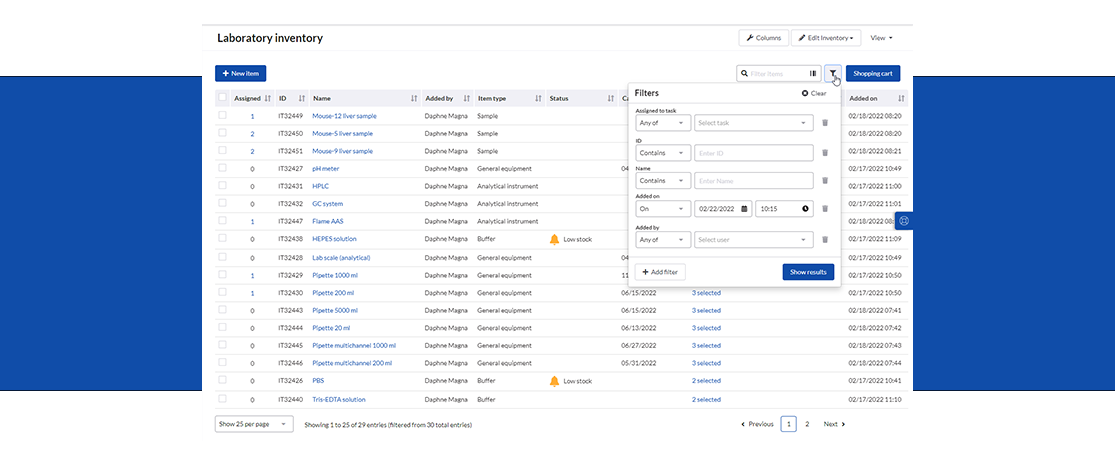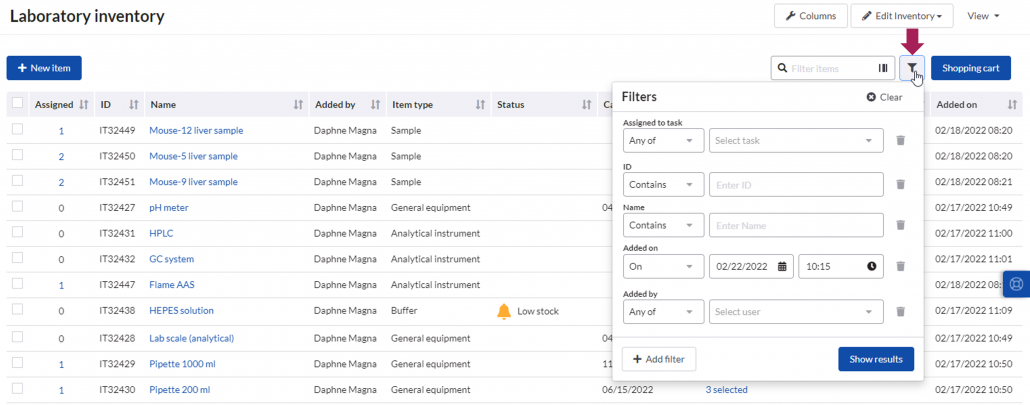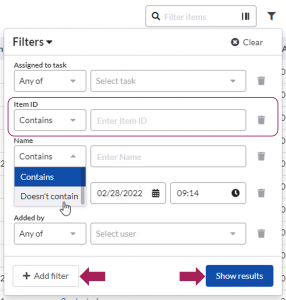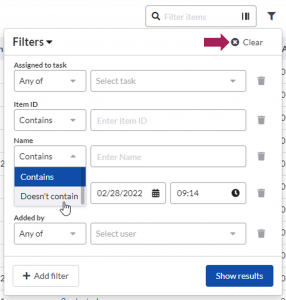Advanced filtering in Inventory
![]() 5 min read
5 min read
SciNote inventories are very flexible and allow you to store information in many custom columns for many samples, reagents, instruments, etc. When you have long lists of items and many columns it can get difficult to find your inventory items.
We are introducing advanced inventory filters to improve findability in SciNote inventories and to make managing your data even simpler. Here is a short guide for you.
Start filtering
To start using advanced filtering in SciNote inventories go into one of your inventories and look for the filter icon next to “Filter items” text field.
Simply click on it to start using your first advanced filter. SciNote offers you right away a set of useful filters based on the inventory default (mandatory) columns such as Name, Added on and others.
How to build a new filter?
Let’s first walk through the filter window to see how it is assembled.
Filter window lists individual filters, which are based on the columns in the inventory. When you open the filter window you will have a few default filters present, which you can continue using or remove.
Each individual filter listed is named by the column name from your Inventory (e.g., Added on) and consists of two filter settings: a filter operator on the left (e.g., This month) and filter value on the right (date). You can select the appropriate filter operator and set a value for each filter to achieve your filtering goal.
You can also remove any individual filter by clicking the delete button at the very right or clear all filters in the window by clicking on the Clear button.
Don’t worry, to add filter(s) back simply click on the “+Add filter” button at the bottom of the filter flyout. This will open a list of columns in the current inventory which you can add as individual filters. In this way, you can create your own customized filter combination.
You can add multiple filters for the same column with different settings.
Note that different inventories will have different filters available.
When you are happy with selected filters and their settings you apply them by clicking the “Show results” button to see filtered items.
Do you notice the red dot on the filter icon? This indicates that filters are applied, and you see filtered inventory items, not all of them.
How do individual filters work together?
When you add several individual filters to the filter list, they are always combined with the logical operator “AND”.
For example, if the filter is composed of the following three individual filters:
Name: Operator: “Contains”, value: “Sample”
Added by: Operator: “Any of”, value: “Polly Ester”
Added on: Operator: “Today”
The items listed will contain word “Sample” in their name and were added by “Polly Ester” today.
Clearing filters
Whenever you want to remove all applied filters, button “Clear” on the top right of filter window comes in handy. It will clear all the individual filters from the list. You need to confirm the disregarded filters by clicking on the “Show results” button. This will return the complete inventory items list.
“Clear” button is very convenient when you want to build a custom filter completely from scratch.
Saving filters
We are quite sure you would like to reuse some filters to save some time. Once you apply a filter you can easily save it by clicking “Save filters” button. You can save the current filter as a new filter by selecting “+New filter” or overwrite the currently applied saved filter by clicking “Overwrite”.
Loading saved filters
You can quickly access saved filters by clicking on the title “Filters” in top row of filter window.
After selecting one of them, you will also know which filter you applied as the filter name will be displayed in the filter window. Useful, isn’t it?
Additionally, all saved filters in a shared inventory are accessible to every user of that inventory.
Existing “simple” inventory filter works together with advanced inventory filters
We are keeping the existing inventory filtering with “Filter items” field exactly as it was. You can continue using it in the same way, it won’t interfere with advanced filters.
You can also combine the simple filter with advanced filters. Both filters will be combined using “AND” logical operator. In other words, using the simple Filter items field you further refine the results you get with advanced filters.
With advanced inventory filters, you will be able to use inventories in additional ways
Powerful filtering in inventories makes it even easier to manage storage locations, batches and more. Read all about these options in a dedicated blog post.
Filter operators explained
Different filters will have different operators. In case you will be using them here are some definitions:
- Contains: Returns items that contain the value in the filter.
- Does not contain: Returns items that do not contain the value in the filter.
- Is empty: Returns items with empty values.
- Any of: Returns items that contain any of the values provided in the filter. This means that the logical operator “OR” is applied between filter values.
- None of: Returns items that do not contain any of the values provided in the filter. This means that the logical operator “OR” is applied between filter values.
- All of: Returns items that contain all values provided in the filter. This means that items with an exact match of listed filter values are returned.
- Equal to: Returns items with an exact match to filter value.
- Not equal to: Returns items that do not match the filter value.
- Greater than: Returns items with values greater than filter value (mathematical operator >).
- Less than: Returns items with values lesser than filter value (mathematical operator <).
- Greater than or equal to: Returns items with values greater than or equal to the filter value (mathematical operator ≥).
- Less than or equal to: Returns items with values lesser than or equal to the filter value (mathematical operator ≤).
- Between: Returns items with values between the filter values “From” and “To”. Specifically, items with values greater than “From” and lower than “To”.
- File is not attached: Returns items that do not contain any attachment in this column.
- File contains: Returns items where the file attached to the column contains the filter value.
Date-related filters also contain the following presets:
- Today: Means date and time greater than 00:00 of the current day and less than 24:00 of the current day.
- Yesterday: Means the previous 24-hour day (date and time greater than 00:00 of the date before today and less than 24:00 of the date before today).
- Last week: Means the previous calendar week (the date and time greater than 00:00 of the Monday of the previous week and less than 24:00 of the Sunday of the previous week.
- This month: Means the current calendar month (the date and time greater than 00:00 of the 1st day of the current month and less than 24:00 of the last day of the current month).
- Last month: Means the previous calendar month (the date and time greater than 00:00 of the 1st day of the previous month and less than 24:00 of the last day of the previous month).
- This year: Means the current calendar year (the date and time greater than 00:00 of the 1st of January of the current year and less than 24:00 of the 31st of December of the current year).
- Last year: Means the previous calendar year (the date and time greater than 00:00 of the 1st of January of the previous year and less than 24:00 of the 31st of December of the previous year).
Note that these time-based presets are “sliding” (relative). In case you will apply a saved filter containing “Today” preset, this will mean “today” on the day when filter will be applied and will not be converted into absolute date & time stamp value.
Filter values explained
Filter values vary from column type to column type and include text fields, numeric fields, a dropdown of values, checklists of values, date and time pickers.
For some filters you can select more than one listed value (e.g., checklists, Assigned to task). Such individual filters will use logical operator OR between these values. For example, filtering items based on column Genetic markers” where you will select “Marker 1” and “Marker 2”, the results will list all items that have sample type “Marker 1”, “Marker 2” as well as items that have both markers.
Filters where you can enter text (e.g., Name) work by matching any whole word you enter.









